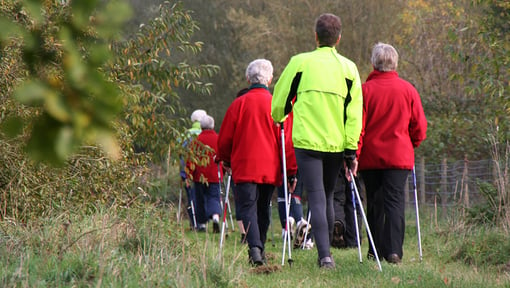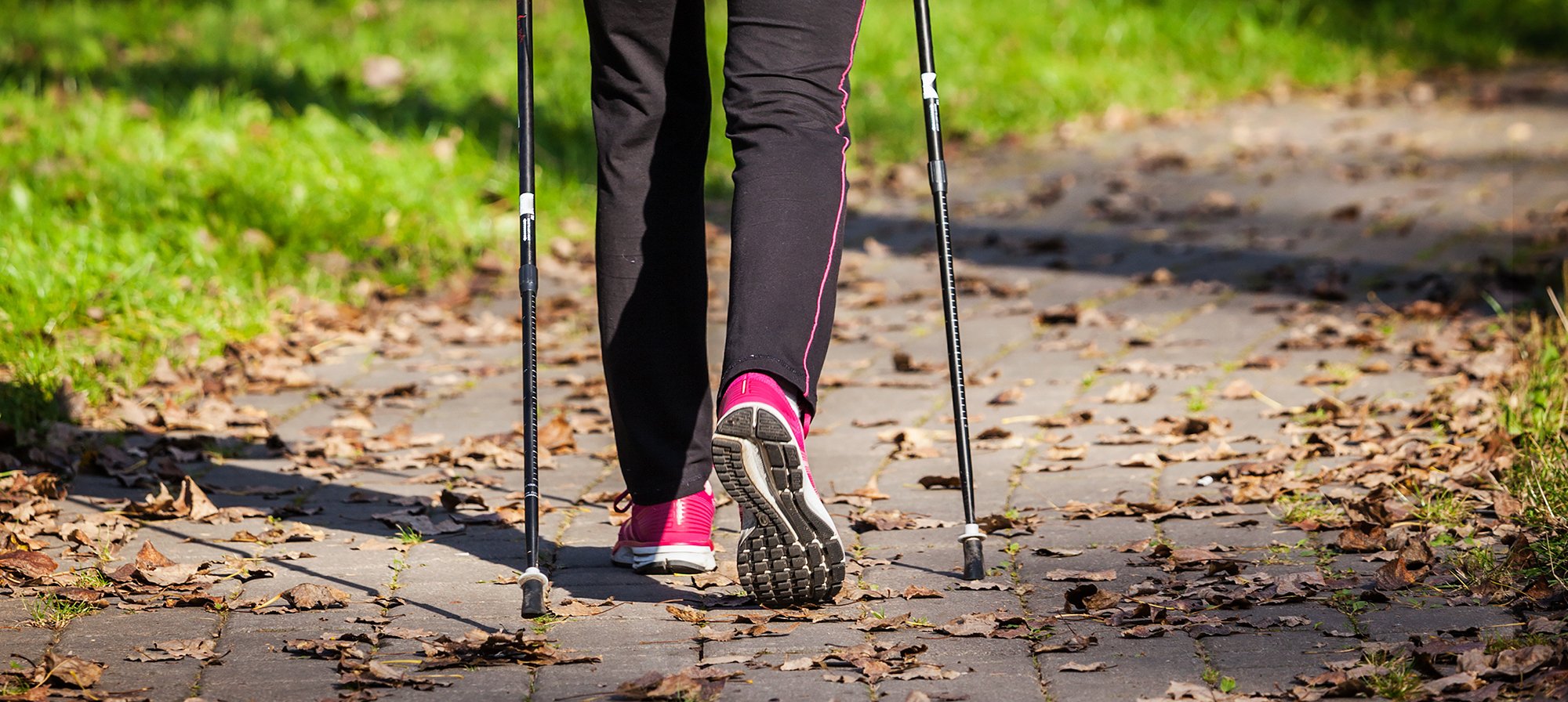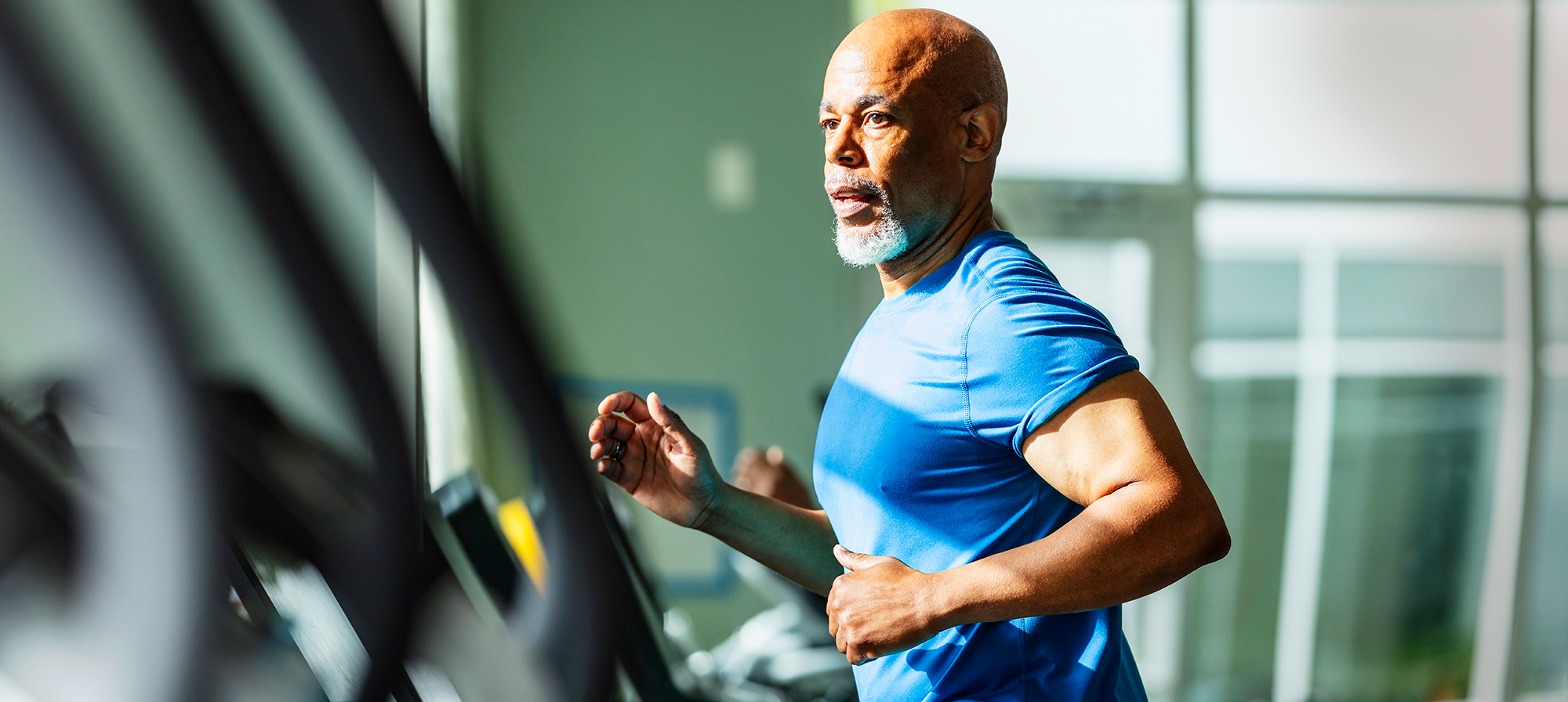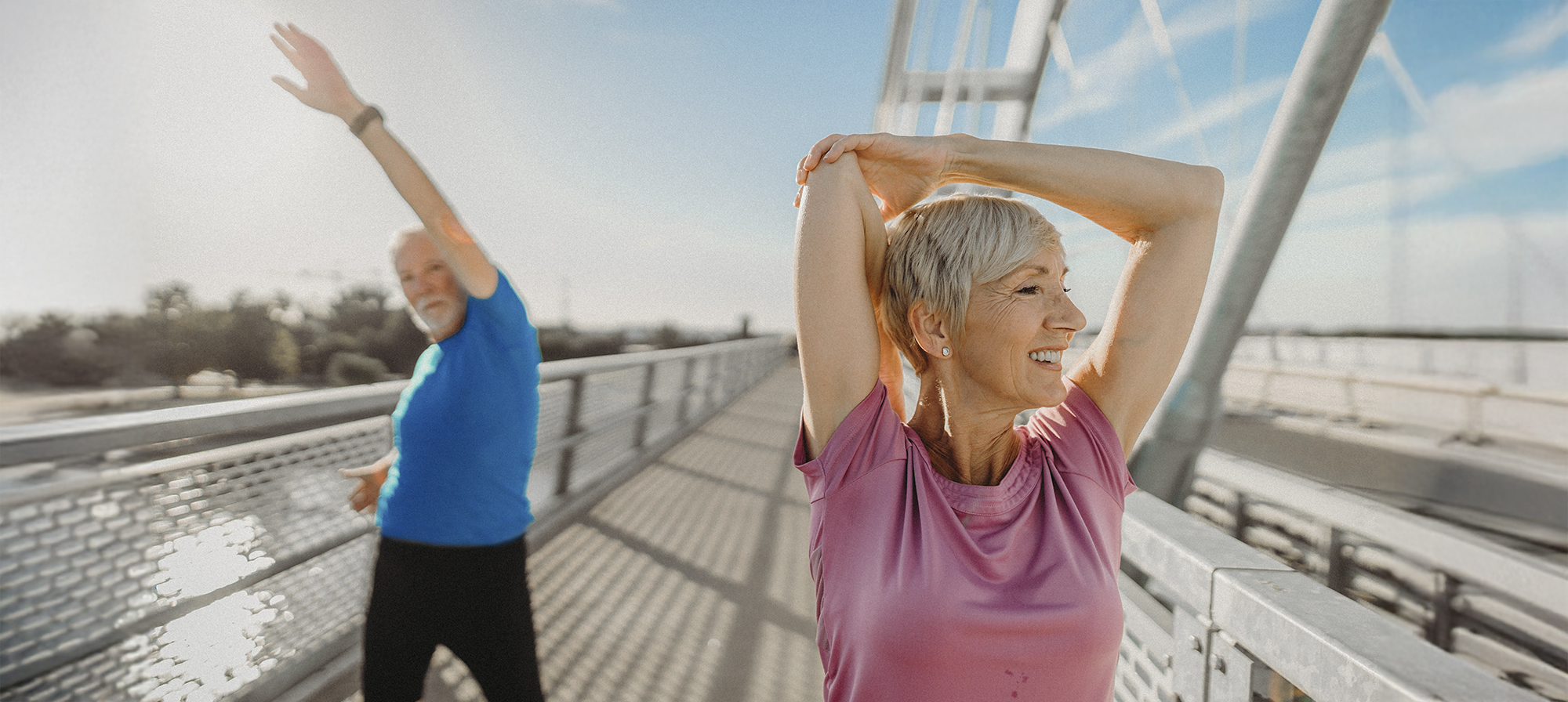Nordic pole walking turns a walk into a calorie-torching, total-body workout. It also brings the fun. So, grab some poles and walk this way!
Clutching one pole in each hand, Nordic pole walkers look like trekkers in search of rugged terrain, or like cross-country skiers in need of skis and snow. But they’re often walking on neighborhood sidewalks, in urban settings, and over manicured park greens. Devoted Nordic walkers say it’s more fun than regular walking. And studies suggest these walkers might be getting a bonanza of fitness benefits.
Nordic walking got its start with cross-country skiers looking to find ways to train in warmer off-season months. But along the way it caught on as an exercise regimen for skiers and nonskiers alike.
While Nordic walking is popular with all age groups, this fitness trend is especially popular with older adults. It’s a vigorous yet low-impact cardio workout that can also help improve your overall balance. And it makes for a great excuse to get together with friends in the outdoors.  With Nordic walking, you can:
With Nordic walking, you can:
- Work more muscles. It is a true total-body workout. In addition to working the muscles in your lower body, you also work your arms, shoulders, chest, back, and abdominal muscles. You’ll engage 80 to 90 percent of your body’s muscles—about twice as many muscles as ordinary walking.
- Burn more calories. One study found that people also burned more calories with Nordic walking than they did with regular brisk walking. But most didn’t feel that they were working any harder. So, you may get the benefits of working harder without feeling the extra effort.
- Improve your posture. Using walking poles encourages you to walk more upright, improving your posture.
- Improve your stability. Walking with any kind of poles provides more points of contact with the ground. But the rubber tips on Nordic walking poles provide even greater traction over all kinds of surfaces and can help lower your risk of falling.
- Help boost bone strength. Bone loss is a real concern for older adults. Walking can help strengthen bone density in your legs and protect against bone loss.
- Help take pressure off your joints. Nordic walking poles can help absorb the impact of the ground, putting less pressure on your hips and knees.
So, would you like to take your walking routine to the Nordic level? Along with a pair of comfortable, supportive shoes, all you’ll really need is a set of walking poles.
Here’s another sport exploding in popularity that you may want to try.
Nordic poles vs. trekking or hiking poles
At first glance, Nordic walking poles don’t seem very different from trekking poles or hiking poles. While they are similar, there are distinctions that set them apart.
Trekking and hiking poles are mainly intended for stability and balance, so they’re a handy tool for covering rugged terrain. While Nordic poles also provide stability and balance, they are mostly designed to help boost your fitness. Flat, groomed ground is ideal because the real workout comes from using the Nordic technique.

Nordic poles use a built-in glove-and-strap system that keeps your hand attached to the pole. These gloves allow your palm (rather than your fingers) to transfer power to the poles. By doing this, the pole becomes an extension of your arm and helps propel you forward. This technique also helps work your upper body and sets this activity apart as a true total-body workout.
Trekking poles also have wrist straps, but the straps are really only meant to keep the pole nearby, should you drop it accidentally. They’re not intended to secure your hands to the poles. So, trekking poles don’t work your upper body the way Nordic poles do.
Finally, while hikers sometimes use just one pole to help with balance, Nordic walkers use both poles. The point, after all, is to get a good workout. Using both poles ensures that you are dividing your effort evenly among all your upper body muscles.
Should you use adjustable or fixed-length poles?
You’ll notice that some Nordic poles are adjustable, and others are a one-piece fixed length. If you’re new to the sport, experts recommend starting with adjustable-length poles. With adjustable poles you won’t have to worry about buying the wrong size. These are also a little easier to transport. You can experiment with the length that suits you best.
As you gain experience and find the pole length that’s right for you, you can look into trying a set of fixed-length poles. One-piece poles tend to be stronger and lighter, but it’s important to make sure they’re the right fit before you commit to them.
You can find walking poles in most sporting goods stores, some general retail stores, and online. Prices range from $20 to $200.
Finding the right length poles
Before you use your poles, be sure they’re set to a length that’s right for you. To do that:
- Hold onto the grips and put the tips of the poles onto the ground.
- Keep the poles straight up and down with your arms close to your body.
- Your elbows should be bent at about 90 degrees.
Some experts suggest setting the poles at 70 percent of your height. For example, if you’re 5’ 9” (69 inches), you should adjust your poles to about 48 inches (69 x .70 = 48).
Getting started
Most walking poles come with instruction booklets to help you get started. You can also find websites and online videos that can help you learn how to use your poles correctly and how to maintain them. As with any new activity you try, it’s a good idea to start at a slow, easy pace and add more effort as you get the hang of it.
Learning the technique
Keep in mind that Nordic pole walking is a bit more involved than simply walking. Learning good technique will help ensure an efficient, safe workout. Fortunately, picking up the basics doesn’t have to take long. Here are some tips to get you going:
- Slip your hand into the attached gloves, secure any Velcro® straps, and grab the handle.
- Step forward with your right foot. Your left arm will swing forward naturally, bringing the pole forward as well.
- Place the tip of the left-hand pole on the ground just in front of your body. Push off the ground with your right foot and the pole at the same time.
- When you swing your left arm back, release your grip. The glove will keep the pole against your hand.
- Continue in this fashion, alternating steps. With practice, the technique will start to feel more natural.
Some people may feel self-conscious about trying Nordic walking by themselves at first. Getting started can be easier and more fun with a group or walking club that is devoted to the sport. Nordic walking clubs are popping up all over the country. If you can’t find one in your area, why not start your own with your friends, neighbors, or coworkers? Or just find a walking buddy who is willing to invest in a set of poles and venture out with you, Nordic-style. It’s a great way to stay both social and fit.
If you’re not ready for as rigorous a walking routine but still want to find a novel way to move more and get outdoors, you can also give plogging a try.
Not a Silver&Fit® member? Learn more about everything the program has to offer, including more helpful healthy living tips like this, here on our website.
This information is not intended to take the place of regular medical care or advice. Please check with your doctor before using this information or beginning any self-care program. Images used for this article do not depict any members of the Silver&Fit Program.
References
Breyer, M. K., Breyer-Kohansal, R., Funk, G. C., Dornhofer, N., Spruit, M. A., Wouters, E. F., Burghuber, O. C., & Hartl, S. (2010). Nordic walking improves daily physical activities in COPD: a randomised controlled trial. Respiratory research, 11(1), 112. https://doi.org/10.1186/1465-9921-11-112
Fritz, T., Caidahl, K., Osler, M., Ostenson, C. G., Zierath, J. R., & Wändell, P. (2011). Effects of Nordic walking on health-related quality of life in overweight individuals with type 2 diabetes mellitus, impaired or normal glucose tolerance. Diabetic medicine: A journal of the British Diabetic Association, 28(11), 1362–1372. https://doi.org/10.1111/j.1464-5491.2011.03348.x
Hartvigsen, J., Morsø, L., Bendix, T., & Manniche, C. (2010). Supervised and non-supervised Nordic walking in the treatment of chronic low back pain: A single blind randomized clinical trial. BMC musculoskeletal disorders, 11, 30. https://doi.org/10.1186/1471-2474-11-30
Jones, K. D. (2011). Nordic walking in fibromyalgia: A means of promoting fitness that is easy for busy clinicians to recommend. [Editorial]. Arthritis Research & Therapy, 13(1), 103. doi:10.1186/ar3225
Nordic Walking Academy. (n.d.). Nordic walking poles or trekking poles? What’s the difference? http://www.nordicacademy.com.au/index.php/about-nordic-walking/nordic-walking-poles/nordic-walking-poles-or-trekking-poles
Nordic Walking Technique. Learn How to Walk with Walking Poles. (n.d.). NordicAcademy.com.au.
https://www.nordicacademy.com.au/index.php/about-nordic-walking/nordic-walking-techniques
Ossowski, Z. M., Skrobot, W., Aschenbrenner, P., Cesnaitiene, V. J., & Smaruj, M. (2016). Effects of short-term Nordic walking training on sarcopenia-related parameters in women with low bone mass: A preliminary study. Clinical interventions in aging, 11, 1763–1771. https://doi.org/10.2147/CIA.S118995
Plumbo, G. (2012). Nordic walking: Pole pushing burns more calories, helps with stability. https://newsnetwork.mayoclinic.org/discussion/nordic-walking-pole-pushing-burns-more-calories-helps-with-stability/
Terada, T., Cotie, L. M., Tulloch, H., Mistura, M., Vidal-Almela, S., O’Neill, C. D, Reid, R. D., Pipe, A., & Reed, J. L. (2022, June 14). Sustained effects of different exercise modalities on physical and mental health in patients with coronary artery disease: A randomized clinical trial. Canadian Journal of Cardiology. doi:10.1016/j.cjca.2022.03.017
Williams, F. (2022, July 11). A beginner’s guide to Nordic walking. Rest Less.
https://restless.co.uk/health/healthy-body/a-beginners-guide-to-nordic-walking/
This article was written by Jason Nielsen, edited by Candace Hodges, and clinically reviewed by Jaynie Bjornaraa, PhD, MPH, PT, LAT, ATC, CSCS, CSPS, on June 5, 2025.





